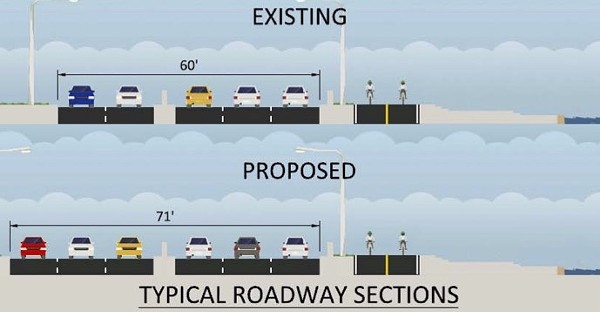We already knew that the city’s Obama Presidential Center transportation plans calls for spending millions on road widening with relatively little attention paid to improving transit, walking, and bike access to the new institution. But now we have a better sense of just how expensive these traffic-inducing measures will be.
To handle expected rush hour overflow traffic from the pedestrianization of Cornell Drive, the mostly six-lane highway that runs through Jackson Park next to the center’s site, the plans calls for adding a new southbound lane to the five-lane segment of Lake Shore Drive between 57th and Hayes Drive, the southern border of the site. Parking would be stripped from Hayes to expand it from two travel lanes to four. And two lanes would be added to Stony Island between 59th and Hayes and one lane to Stony from 63rd to 67th. All told, there would be a net gain of three to five acres of green space. Mayor Rahm Emanuel had previously indicated that the widening of LSD alone would cost upward of $100 million, which he hoped to pay for with state funds.
Today the Chicago Department of Transportation released a statement with preliminary estimate that the total package of transportation changes, “which would streamline traffic through the park, add publicly accessible open space and improve pedestrian and bicyclist pathways to provide better access to and within the park” may cost about $175 million, depending on the final designs. CDOT didn’t provide a cost breakdown, but that number does include a few bike/pedestrian underpasses, which is a positive development.
The CDOT statement confirms that the city is pursuing state funding for the changes from the state, which has jurisdiction over both LSD and Cornell, adding that Chicago will look for other funding sources as well. “Presidential libraries/museums often receive state funding for related infrastructure projects,” the statement notes. “Here in Illinois, the state provided $100 million starting in 1998 for construction of the Abraham Lincoln Presidential Library and Museum.
It's worth noting that in 2017 the state budget deal cut $76 million in funding for the CTA, Metra, and Pace, forcing all three agencies to raise fares and/or cut service this year.
In addition to being expensive, the Obama center-related expansions would actually encourage more driving. Even with the closure of Cornell, the widening of Lake Shore Drive and Stony Island would create enough capacity for 95,000 vehicles per day, 7,900 more than are currently using the three roadways in the area, and a full 14,800 more cars than are projected to use LSD and Stony by 2040, according to CDOT. This is the wrong strategy for a city with the stated goals of reducing car dependency and fighting climate change.
This approach also ignores the phenomenon of "traffic evaporation"—when road capacity is decreased, some drivers respond by avoiding unnecessary trips or switching to other modes. So if we closed Cornell without adding capacity elsewhere, it's likely many of the current trips would disappear, especially if CTA and Metra service were increased.
If we conservatively guess that $125 million of that $175 million will be used for the expansion of Lake Shore Drive and Stony Island, think about what kind of transit improvements could be made to encourage residents and visitors not to take private vehicles to the center? (Current plans include a 400-450-car underground garage below the campus.)
Surely there are ways that $125 million could be spent that would encourage people to get to the Obama center in an environmentally friendly way rather than driving there. For example, the brand new Morgan Green Line station in the West Loop cost only $38 million. The CTA’s Ashland bus rapid transit proposal which would have create the equivalent of a new ‘L’ route for much of the length of the city, is projected to cost a mere $10 million a mile.
Local transportation experts Steve Schlickman and Joe Schwieterman have proposed running a year-round express bus to the center and the Museum of Science and Industry with branded bus stops that would make it easy for tourists to find them. If it’s a forgone conclusion that officials are going to spend millions in taxpayer dollars to promote driving, let’s at least see the city pursue this commonsense idea.





